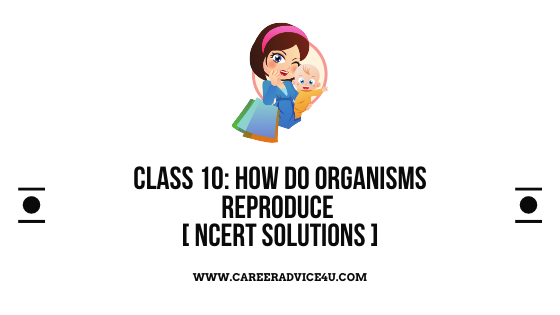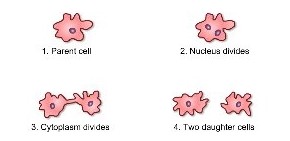
Class 10 NCERT Solutions Science ( Biology )
Question 1: Explain the importance of reproduction in organisms.
Ans: Reproduction is important for the survival of life on earth. Reproduction is a phenomenon in which organisms give birth to their young ones ( or basically offsprings) which are quite identical to them. They show similar characteristics. If reproduction will stop then the idea of life cycle itself will come to an end.
Question 2: Describe the process of fertilization in human beings
Ans: The process of fertilization involves the fusion of male gametes with the female gametes. Both male and female have reproductive organs which produce gametes. Fertilization takes place when the sperms released from the penis meet the female eggs passing through the vagina. The process of fertilization completes in the fallopian tubes. After the sperm meets the egg the formation of the zygote takes place. This zygote then gradually develops and forms a foetus.
Question 3: Choose the most appropriate answer.
Internal fertilization occurs
(a) In the female body
(b) outside female body
(c) in the male body
(d) outside male body
Ans:
(a) Internal fertilization takes place in the female’s body
(ii) A tadpole develops into an adult frog by the process of
(a) fertilization
(b) Metamorphosis
(c) Embedding
(d) Budding
Ans: A tadpole develops into an adult frog by the process of metamorphosis
(iii) The number of nuclei present in a zygote is:
(a) none
(b) one
(c) two
(d) four
Ans: The number of nuclei present in a zygote is one
Also Read: CBSE Class 10 NCERT Solutions Control and Coordination
Question 4: Indicate whether the following statements are True or False:
(a) Oviparous animals give birth to young ones
Ans: False
(b) Each sperm is a single cell
Ans: True
(c) External Fertilization takes place in frogs
Ans: True
(d) A new human individual develops from a cell called gamete
Ans: False
(e) Egg made after fertilization is made up of single cell
Ans True
(f) Amoeba reproduces by budding
Ans: False
Also Read: The Book That Saved The Earth Summary
Ques 5: Give two differences between a zygote and a foetus
Ans:
| Zygote | Foetus |
|---|---|
| After the sperm meets the egg a zygote is formed after fertilization | It is a more developed form of the organism and various body parts can be recognized |
| The division of zygote takes multiple times before the formation of an embryo | An embryo slowly converts into a foetus |
| It is single cell | It is a multi cellular structure |
Ques 6: Define Asexual Reproduction. Describe two methods of sexual reproduction in animals
Ans: Asexual Reproduction is a form of reproduction in which new offsprings are formed without the need for fusion between male and female gametes. Only a single parent is enough in this mode of reproduction. The child formed will be quite identical to the parent.
Two methods of Asexual Reproduction Are:
(i) Binary Fission
It is one of the Asexual methods of reproduction. In this process, a single parent divides into 2 parts. A single nucleus divides into two separate nuclei gradually and then both the parts separate from each other and two new offsprings are formed. Some of the organisms which reproduce by this mode of nutrition are Amoeba and Bacteria.

(ii) Budding
Budding is another method that falls under the asexual mode of reproduction. In Budding a parent develops buds. These buds grow outwards on the parent until they become mature enough. After getting matured, they get removed from the parent. Hydra shows budding.
Download: Free CBSE Sample Paper for Class 10
Question 7: In which female organ does the embryo get embedded?
In a female body, the embryo gets embedded into the wall of the uterus. Various parts of the body start developing with time. Some of the parts that are identically visible are hands, legs, and eyes. The stage after this process leads to the formation of the foetus.
Question 8: What is Metamorphosis? Give examples.
Metamorphosis is a process in which the larva will convert gradually into an adult one. When metamorphosis occurs various changes can be seen in the body of the organism. Some changes completely modify the structure of the organism. Some of the organisms in which metamorphosis can be noticed are Frogs and insects.
Life Cycle of a Frog
The life cycle of the frog is as follows. First of all, a tadpole develops from the egg. The tadpole is quite small and has an identical tail and a mouth. Then after the limbs and lungs start developing it attains the stage of an adult frog. The structure of tadpole changes due to metamorphosis.
Question 9: Differentiate between internal fertilization and external fertilization.
| Internal Fertilization | External Fertilization |
|---|---|
| It takes place inside the female's body when the male egg cell meets with the female gamete | It takes place outside the female body when the male and female gamete fuses |
| It has more chances of the offspring's survival and hence less number of eggs will be produced | The chance of survival for the young one is less, so more eggs are produced |
| Ex Human beings and cows | Ex. Salmon and Cod |
So, these were the NCERT Solutions for Class 10, Science Chapter, How do organisms reproduce. Hope you find this useful. Don’t forget to follow our Facebook page to stay updated with latest Class 10 updates and sample papers.
- DAV Class 7 Science Solutions With Explanations: All Chapters - February 6, 2022
- Pollution of Water Question Answers | DAV Class 8 Science - February 4, 2022
- Fabric from Fibre Solutions | DAV Class7 Science Chapter 14 - January 25, 2022

Leave a Reply